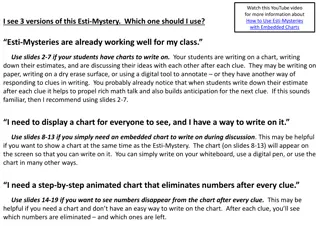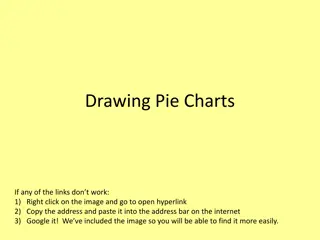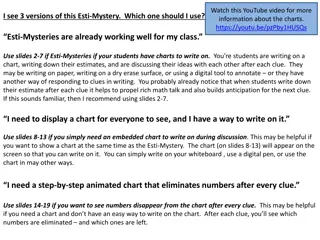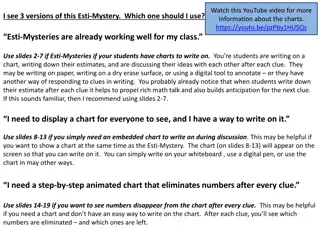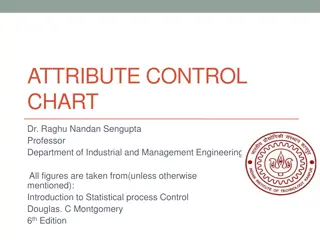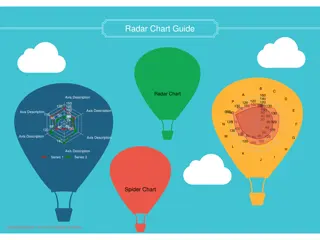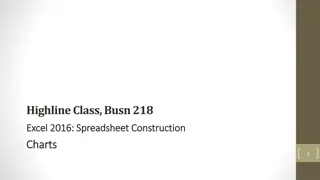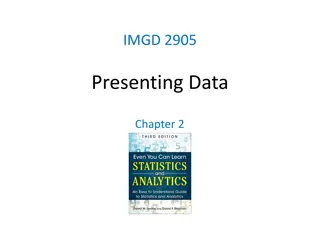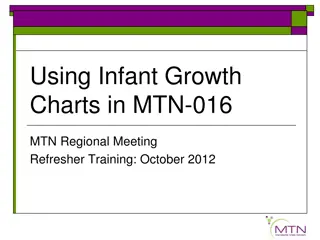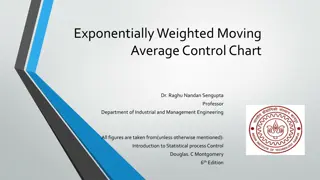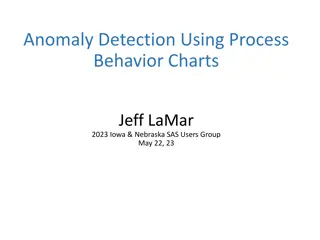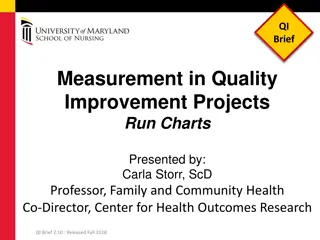Understanding the Limitations of Shewhart Control Charts in Process Monitoring
Shewhart control charts, while effective for detecting larger process shifts, have limitations in detecting smaller shifts due to relying on individual sample observations. This can be a drawback in phase II process monitoring scenarios where smaller shifts are of interest. Alternatives like the cumulative sum (CUSUM) control chart and exponentially weighted moving average (EWMA) control chart offer more sensitivity to small shifts, providing valuable insights in maintaining process control and quality assurance.
Download Presentation

Please find below an Image/Link to download the presentation.
The content on the website is provided AS IS for your information and personal use only. It may not be sold, licensed, or shared on other websites without obtaining consent from the author. Download presentation by click this link. If you encounter any issues during the download, it is possible that the publisher has removed the file from their server.
E N D
Presentation Transcript
Cumulative Sum Chart Dr. Raghu NandanSengupta Professor Department of Industrial and Management Engineering All figures are taken from(unless otherwise mentioned): Introduction to Statistical process Control Douglas. C Montgomery 6thEdition
Problem with Shewhartcharts in Phase 2 monitoring A major disadvantage of a Shewhartcontrol chart is that it uses only the information about the process contained in the last sample observation and it ignores any information given by the entire sequence of points. This feature makes the Shewhartcontrol chart relatively insensitive to small process shifts, say, on the order of about 1.5 or less. This potentially makes Shewhartcontrol charts less useful in phase II monitoring problems, where the process tends to operate in control, reliable estimates of the process parameters (such as the mean and standard deviation) are available, and assignable causes do not typically result in large process upsets or disturbances. Use of warning limits or similar procduresreduce the simplicity and ease of interpretation of the Shewhartcontrol chart, and as we have previously observed, they also dramatically reduce the average run length of the chart when the process is actually in control. This can be very undesirable in phase II process monitoring. Two very effective alternatives to the Shewhartcontrol chart may be used when small process shifts are of interest: the cumulative sum (cusum) control chart, and the exponentially weighted moving average (EWMA) control chart.
The CUSUM Control Chart Consider the data given in the table The first 20 of these observations were drawn at random from a normal distribution with mean = 10 and standard deviation = 1. Using these the Shewhart control chart is drawn
The chart Notice that all 20 points are in control, however
Failure of detecting small shifts The last 10 observations in column (a) of Table 9.1 were drawn from a normal distribution with mean m = 11 and standard deviation = 1. Consequently, we can think of these last 10 observations as having been drawn from the process when it is out of control that is, after the process has experienced a shift in the mean of 1 . These last 10 observations are also plotted on the control chart in Fig. 9.1. None of these points plots outside the control limits, so we have no strong evidence that the process is out of control. Note that there is an indication of a shift in process level for the last 10 points, because all but one of the points plot above the center line. If we rely on the traditional signal of an out-of-control process, one or more points beyond a three-sigma control limit, then the Shewhartcontrol chart has failed to detect the shift. The reason for this failure, of course, is the relatively small magnitude of the shift. The Shewhartchart for averages is very effective if the magnitude of the shift is 1.5 to 2 or larger. For smaller shifts, it is not as effective.
Plotting the CUSUM chart The cusumchart directly incorporates all the information in the sequence of sample values by plotting the cumulative sums of the deviations of the sample values from a target value. Suppose that samples of size n 1 are collected, and xjis the average of the jth sample. Then if 0is the target for the process mean, the cumulative sum control chart is formed by plotting the quantity against the sample number i.
Ways to represent CUSUM Because they combine information from several samples, cumulative sum charts are more effective than Shewhart charts for detecting small process shifts. They are particularly effective with samples of size n=1. This makes the cumulative sum control chart a good candidate for use in the chemical and process industries where rational subgroups are frequently of size 1, and in discrete parts manufacturing with automatic measurement of each part and on-line process monitoring directly at the work center. There are two ways to represent cusums, the tabular (or algorithmic) cusum, and the V-mask form of the cusum. Of the two representations, the tabular cusum is preferable. We will not discuss the V-mask procedure in this course.
The Tabular or Algorithmic Cusum for Monitoring the Process Mean Cusums may be constructed both for individual observations and for the averages of rational subgroups. Let xibe the ithobservation on the process. When the process is in control, xi has a normal distribution with mean 0and standard deviation . We assume that either s is known or that a reliable estimate is available. These assumptions are very consistent with phase II applications of SPC. Sometimes we think of 0as a target value for the quality characteristic x. This viewpoint is often taken in the chemical and process industries when the objective is to control x (viscosity, say) to a particular target value (such as 2000 centistokes at 100 C). If the process drifts or shifts off this target value, the cusum will signal, and an adjustment is made to some manipulatablevariable (such as the catalyst feed rate) to bring the process back on target. Also, in some cases a signal from a cusum indicates the presence of an assignable cause that must be investigated just as in the Shewhartchart case.
The cusum values The tabular cusumworks by accumulating derivations from 0that are above target with one statistic C+and accumulating derivations from 0that are below target with another statistic C . The statistics C+and C are called one-sided upper and lower cusums.
Estimating K and H K is usually called the reference value (or the allowance, or the slack value), and it is often chosen about halfway between the target 0and the out-of- control value of the mean 1that we are interested in detecting quickly. Considering We can calculate K as If either C+ior C-iexceeds the decision interval H, the process is considered to be out of control One rule of thumb to calculate H is to calculate H as 5 times the process standard deviation
Conclusions from the chart The upperside cusumat period 29 is C+29 = 5.28. Since this is the first period at which C+i> H = 5, we would conclude that the process is out of control at that point. The tabular cusumalso indicates when the shift probably occurred. The counter N+records the number of consecutive periods since the upper-side cusumC+irose above the value of zero. Since N+= 7 at period 29, we would conclude that the process was last in control at period 29 7 = 22, so the shift likely occurred between periods 22 and 23.
Calculating new mean In situations where an adjustment to some manipulatable variable is required in order to bring the process back to the target value 0, it may be helpful to have an estimate of the new process mean following the shift. This can be computed from Consider the cusumin period 29 with C+29=5.28
Recommendations for cusum The tabular cusumis designed by choosing values for the reference value K and the decision interval H. It is usually recommended that these parameters be selected to provide good average run length performance. Define H = h and K = k , where is the standard deviation of the sample variable used in forming the cusum. Using h=4 or h=5 and k= 1 2 will generally provide a cusumthat has good ARL properties against a shift of about 1 in the process mean. K is chosen relative to the size of the shift that we want to detect, then we select h
Standardized Cusum Many users of the cusumprefer to standardize the variable xibefore performing the calculations. Let be the standardized value of xi. Then:
Advantages of standardized CUSUM Many cusumcharts can now have the same values of k and h, and the choices of these parameters are not scale dependent (that is, they do not depend on ). Second, a standardized cusumleads naturally to a cusumfor controlling variability,
The Fast Initial Response or Headstart Feature Aims to improve the sensitivity of a cusum at process start-up Increased sensitivity at process start-up would be desirable if the corrective action did not reset the mean to the target value. The fast initial response (FIR) or headstart essentially just sets the starting values C+ 0and C 0equal to some nonzero value, typically H/2. This is called a 50% headstart.
An example Consider the below data:
Continued.. These data have a target value of 100, K = 3, and H = 12. We will use a 50% headstart value of C+0= C 0=H/2 = 6. The first 10 samples are in control with mean equal to the target value of 100. Since x1= 102, the cusums for the first period will be : The starting cusum value is the headstart H/2 = 6. From period 2 onward C+1is unaffected by the headstart, and from period 3 onward C 1is unaffected by the headstart. This has occurred because the process is in control at the target value of 100, and several consecutive observations near the target value were observed.
A Cusum for Monitoring Process Variability Let xi be the normally distributed process measurement with mean or target value 0and standard deviation . The standardized value of xiis A new standardized quantity can be created: Since the in-control distribution of viis approximately N(0,1), two one- sided standardized scale (i.e., standard deviation) cusumscan be established as follows(in the next slide).
Values of scale cusum where S+0= S 0= 0 and the values of k and h are selected as in the cusum for controlling the process mean. The interpretation of the scale cusum is similar to the interpretation of the cusum for the mean. If the process standard deviation increases, the values of S+iwill increase and eventually exceed h, whereas if the standard deviation decreases, the values of S iwill increase and eventually exceed h.
Rational Subgroup Although we have given the development of the tabular cusum for the case of individual observations (n = 1), it is easily extended to the case of averages of rational subgroups where the sample size n > 1. Simply replace xiby xi(the sample or subgroup average) in the above formulas, and replace with / n. With Shewhart charts, the use of averages of rational subgroups substantially improves control chart performance. However, this does not always happen with the cusum. Only if there is some significant economy of scale or some other valid reason for taking samples of size greater than unity should one consider using n > 1 with the cusum. One practical reason for using rational subgroups of size n>1 is that we could now set up a cusum on the sample variance and use it to monitor process variability.



